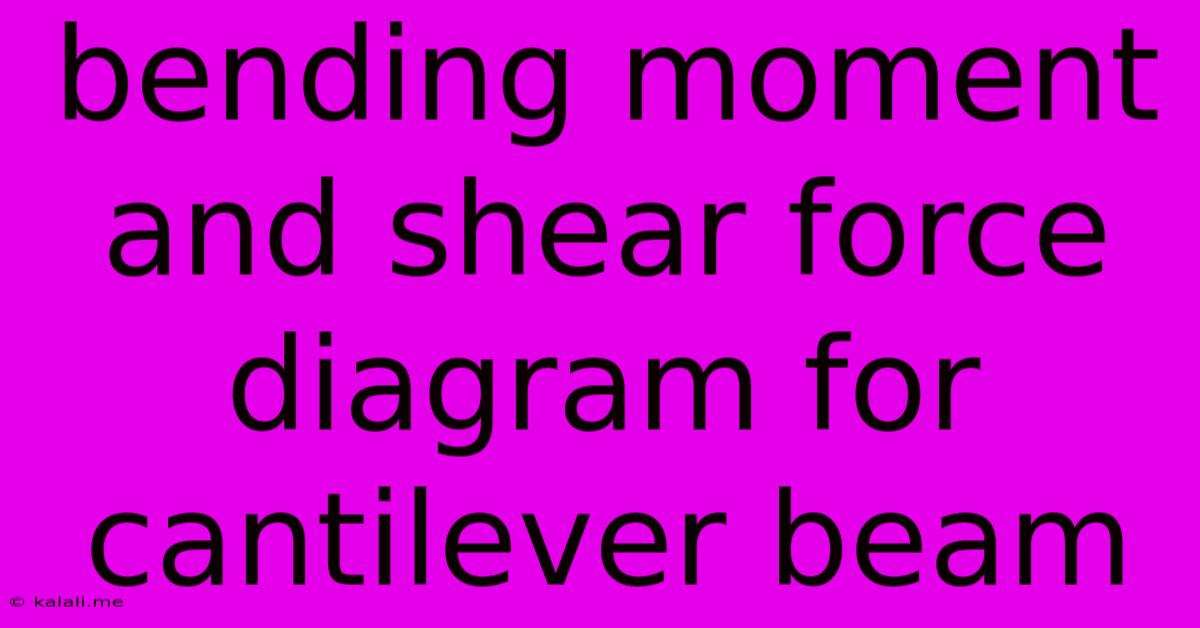Bending Moment And Shear Force Diagram For Cantilever Beam
Kalali
Jun 12, 2025 · 4 min read

Table of Contents
Bending Moment and Shear Force Diagrams for Cantilever Beams: A Comprehensive Guide
Understanding bending moment and shear force diagrams is crucial for structural engineers and anyone involved in designing and analyzing beams. This guide will provide a clear explanation of how to draw these diagrams for cantilever beams, focusing on the underlying principles and practical applications. We'll cover various loading conditions to solidify your understanding. This comprehensive guide will help you master the concept and confidently tackle related problems.
What is a Cantilever Beam?
A cantilever beam is a structural element fixed at one end and free at the other. This configuration results in unique stress distributions compared to simply supported or overhanging beams. The fixed end resists both rotation and translation, leading to concentrated reactions at that point. Understanding this fundamental characteristic is key to correctly determining shear force and bending moments.
Understanding Shear Force and Bending Moment
-
Shear Force: This represents the internal force acting parallel to the cross-section of the beam. It's the algebraic sum of all vertical forces acting on either side of a section. A positive shear force indicates upward force on the left side of the section, or a downward force on the right.
-
Bending Moment: This is the internal moment (or turning effect) acting on the cross-section of the beam. It's calculated as the algebraic sum of the moments of all forces acting on either side of a section. A positive bending moment causes compression at the top and tension at the bottom of the beam.
Steps to Draw Shear Force and Bending Moment Diagrams
The process involves several key steps:
-
Determine the Reactions: Begin by calculating the reaction forces at the fixed support. For cantilever beams, this typically involves considering the summation of vertical and moment equilibrium.
-
Draw the Shear Force Diagram: Move along the beam, considering the forces acting on each section. The shear force at any point is the algebraic sum of the vertical forces to the left (or right) of that point. Plot these values on a diagram with the shear force on the y-axis and the beam length on the x-axis.
-
Draw the Bending Moment Diagram: Similar to the shear force diagram, consider the moments acting on each section. The bending moment at any point is the algebraic sum of the moments to the left (or right) of that point. Remember that the area under the shear force diagram represents the change in bending moment. Plot these values on a diagram with the bending moment on the y-axis and beam length on the x-axis.
Example: Cantilever Beam with a Point Load
Let's consider a cantilever beam of length 'L' subjected to a point load 'P' at the free end.
-
Reactions: The fixed end will experience a vertical reaction force of 'P' upwards and a moment reaction of 'PL' (clockwise).
-
Shear Force Diagram: The shear force will be constant and equal to 'P' along the entire length of the beam.
-
Bending Moment Diagram: The bending moment will vary linearly, starting from 'PL' at the fixed end and decreasing to zero at the free end.
Example: Cantilever Beam with a Uniformly Distributed Load (UDL)
Consider a cantilever beam of length 'L' with a uniformly distributed load 'w' (force per unit length).
-
Reactions: The fixed end will experience an upward vertical reaction force of 'wL' and a moment reaction of 'wL²/2' (clockwise).
-
Shear Force Diagram: The shear force will vary linearly, starting at '-wL' at the free end and increasing to zero at the fixed end.
-
Bending Moment Diagram: The bending moment will vary parabolically, starting from zero at the free end and reaching a maximum of 'wL²/2' at the fixed end.
Interpreting the Diagrams
The shear force and bending moment diagrams are essential tools for:
-
Determining Maximum Shear Force and Bending Moment: These values are critical for designing the beam to ensure it can withstand the applied loads without failure.
-
Identifying Critical Sections: The diagrams highlight locations with the highest stresses, helping engineers to focus their design efforts.
-
Assessing Structural Integrity: They provide valuable insights into the beam's response to loading, enabling engineers to assess its structural integrity and safety.
Conclusion
Mastering the ability to create accurate shear force and bending moment diagrams for cantilever beams is a fundamental skill in structural analysis. This guide has provided a clear, step-by-step approach, illustrated with practical examples. By understanding the principles and practicing these techniques, you'll be well-equipped to analyze and design various cantilever beam structures. Remember that practice is key – work through different load cases to build your confidence and understanding.
Latest Posts
Latest Posts
-
Anything That Has Mass And Occupies Space Is Called
Jun 13, 2025
-
What Are The Factors Of 89
Jun 13, 2025
-
Which Of The Following Is An Igneous Rock
Jun 13, 2025
-
The Molten Rock Inside The Earth Is Called
Jun 13, 2025
-
Which Planet Is The Least Dense
Jun 13, 2025
Related Post
Thank you for visiting our website which covers about Bending Moment And Shear Force Diagram For Cantilever Beam . We hope the information provided has been useful to you. Feel free to contact us if you have any questions or need further assistance. See you next time and don't miss to bookmark.